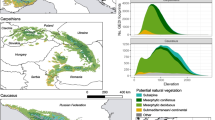Abstract
Acting under the auspices of the US Endangered Species Act, we quantified wind erosion and its effects on rare and common plant species on a semi-arid military installation in Hawaii. Our goal was to develop management strategies, based on local data, to aid the conservation of rare and common indigenous plants and their habitats. We collected windblown soil coming off of roads and other disturbed soils to assess likely impacts to plants occurring at certain heights and distances from disturbed surfaces. We then subjected plants in a glasshouse to windblown dust treatments, designed from our field data to simulate erosion events, and evaluated the effect of these treatments on photosynthesis and survival. We also designed several field experiments to examine the in-situ effects of windblown soil and soil substrate on germination, growth rate, and survival of indigenous and nonindigenous plants. We conclude from these experiments that most direct effects of windblown soil to plants can be effectively mitigated by locating roads and training areas at least 40 m from sensitive plant habitats and through vegetation management to maintain at least 11% aerial cover on disturbed surfaces. Effects of soil type on germination, growth, and survival was species-specific, emphasizing the importance of species trials prior to, or during, rehabilitation efforts.




Similar content being viewed by others
References
Armbrust DV (1984) Wind sandblast injury to field crops: effect of plant age. Agronomy Journal 76:991–993
Armbrust DV (2001) Plant tolerance to sandblast damage in Ascough JC, Flanagan DC (eds.), Soil erosion research for the 21st Century, proceedings of international symposium. Honolulu, HI, USA
Armbrust DV, Paulsen GM (1973) Effect of wind and sandblast injury on nitrate accumulation and on nitrate reductase activity in soybean seedlings. Communications in Soil Science and Plant Analysis 4:197–204
Armbrust DV, Paulsen GM, Ellis R (1974) Physiological responses to wind- and sandblast-damaged winter wheat plants. Agronomy Journal 66:421–423
Armbrust DV, Retta A (2002) Wind and sandblast damage to growing vegetation. Annals of Arid Zone 39:273–284
Burkhardt J, Kaiser H, Kappen L, Goldbach HE (2002) The possible role of aerosols on stomatal conductivity for water vapour. Basic and Applied Ecology 2:351–364
Englert N (2004) Fine particles and human health - a review of epidemiological studies. Toxicology Letters 149:235–242
Fryrear DW (1986) A field dust sampler. Journal of Soil and Water Conservation 41:117–120
Fryrear DW (1995) Soil losses by wind erosion. Soil Science Society of America Journal 59:668–672
Grantz DA, Garner JHB, Johnson DW (2003) Ecological effects of particulate matter. Environment International 29:213–239
Hedin LO, Vitousek PM, Matson PA (2003). Nutrient losses over four million years of tropical forest development. Ecology 84:2231–2255
Johnson AH, Andersen SB, Siccama TG (1994) Acid rain and the soils of the Adirondacks. I. Changes in pH and available calcium, 1930–1984. Canadian Journal of Forest Research 24:39–45
Kappos AD, Bruckmann P, Eikmann T, Englert N, Heinrich U, Hoeppe P, Koch E, Krause GHM, Kreyling WG, Rauchfuss K, Rombout P, Schulz-Klemp V, Thiel WR, Wichmann H (2004) Health effects of particles in ambient air. International Journal of Hygiene & Environmental Health 207:399–407
Little TM, Hills FJ (1978) Agricultural experimentation, design and analysis. John Wiley and Sons, New York, USA, 350 pp
Ots K, Rauk J (2001) Defoliation of Scots pine and Norway spruce under alkaline dust impact and its relationship with radial increment. Oil and Shale 18:223–237
Prusty BAK, Mishra PC, Azeez PA (2005) Dust accumulation and leaf pigment content in vegetation near the national highway at Sambalpur, Orissa, India. Ecotoxicology and Environmental Safety 60:228–235
Saxton K, Chandler D, Stetler L, Lamb B, Claiborn C, Lee BH (2000) Wind erosion and fugitive dust fluxes on agricultural lands in the Pacific Northwest. Transactions of the American Society of Agricultural Engineers 43:623–630
Skidmore J, Tatarko J (1990) Stochastic wind simulation for erosion modeling. Transactions of the American Society of Agricultural Engineers 33:1893–1899
Sharifi MR, Gibson AC, Rundel PW (1997) Surface dust impacts on gas exchange in Mojave Desert shrubs. Journal of Applied Ecology 34:837–846
Sharifi MR, Gibson AC, Rundel PW (1999) Phenological and physiological responses of heavily dusted creosote bush (Larrea tridentata) to summer irrigation in the Mojave Desert. Flora 194:369–378
Shaw RB, Bern CM, Schulz KA, Diersing VE, Tazik DJ (1990) U.S. Army land condition/trend analysis of the Pohakuloa Training Area, Hawaii. Tropical Hydrology and Caribbean Water Resources, American Water Resources Association, July 1990 issue
Shaw RB, Castillo MJ (1997) Plant communities of Pohakuloa Training Area. Center for Ecological Management of Military Lands, Fort Collins, Colorado, USA
Snedecor GW, Cochran WG (1980) Statistical methods, 7th Edition. Iowa State University Press, Ames, Iowa, USA
Wang QR, Cui YS, Liu XM, Dong YT, Christie P (2003) Soil contamination and plant uptake of heavy metals at polluted sites in China. Journal of Environmental Science and Health 38:823–838
Woodruff NP, Siddoway FH (1965) A wind erosion equation. Soil Science Society of America Proceedings 29:602–608
Zaady E (2005) Seasonal change and nitrogen cycling in a patchy Negev Desert: a review. Arid Land Research and Management 19:111–124
Zobeck TM, Parker NC, Haskell S, Guoding K (2000) Scaling up from field to region for wind erosion prediction using a field-scale wind erosion model and GIS. Agriculture, Ecosystems and Environment 82:247–259
Acknowledgments
This study was funded by the U.S. Army, Garrison Hawaii. We would like to thank the PTA Commander, LTC Fred Clarke, as well as U.S. Army Environmental personnel Joel Godfrey and Alvin Char for their support of the study. We also thank Kathy Kawakami and Sydney Cardea for providing their technical expertise in the glasshouse. We are also grateful for the participation of the USF&WS, Honolulu Office for their kind patience and collaboration on the study.
Author information
Authors and Affiliations
Corresponding author
Rights and permissions
About this article
Cite this article
Gleason, S.M., Faucette, D.T., Toyofuku, M.M. et al. Assessing and Mitigating the Effects of Windblown Soil on Rare and Common Vegetation. Environmental Management 40, 1016–1024 (2007). https://doi.org/10.1007/s00267-007-9004-3
Received:
Accepted:
Published:
Issue Date:
DOI: https://doi.org/10.1007/s00267-007-9004-3




